

Die Fernweh Bilder
The Bavarian Countryside



My favorite place to visit in Germany is the German countryside in the state of Bavaria. Bavaria or Bayern, as it is called in German, is one of the southernmost states of Germany. While the state of Bavaria is home to a couple of large cities, such as Munich and Nuremberg, it is primarily the location of the beginning of the Alps, lush farmlands, idyllic landscapes, and countryside.
I travelled to the Bavarian countryside twice, once as a young child, to the town of Maierhöfen and later after graduating high school to the town of Chiemgau. I was young enough during my first trip there, not to care much about holding a camera. I was more "caught up in the moment." Therefore, all the images I've supplied accompanying the description of my first trip are not my photos, but royalty free, public domain stock photos.
Which experience do you want to read about, Maierhöfen or Chiemgau?



The First Trip: Maierhöfen
The Stay:
The resort also had a full club area, where one could go to workout (although as a seven year old I cared much less about this and I was much more interested in the indoor pool with a lazy river, and waterslide), as well as an outdoor park for children. I remember that the resort had a holiday, once a year—designated “Kinder Tag,” or “Children’s Day”—on which workers from the resort and travelling performers would come and entertain the children—all included with the cost of the stay. The cost of the stay was approximately 91 Euros a night. Click the button to go to the Maierhöfen resort webpage.
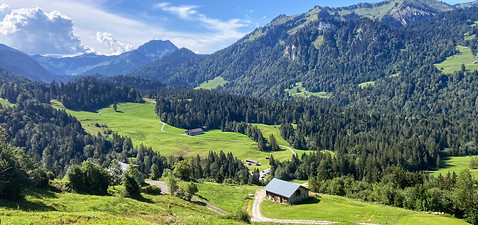
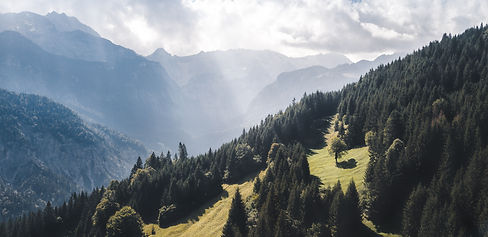
During my first trip to the Bavarian countryside, our bungalow, part of the Ferienclub Maierhöfen resort, allowed for two bedrooms, a bathroom, a small living area, dining area, and a kitchen. It connected to a bungalow nextdoor, where friends of our family who had travelled with us were staying.
There was also a small patio and backyard, where guests could hang clothes after washing (by hand) to dry, as well as some seats and a small table. I remember that we would often go out for the day, sight-seeing or hiking, since the resort itself was located in the middle of the Alps, but that we would save money by buying our own groceries and cooking our own food in the bungalow. After dinner, we would often pass the time with a game of ‘Memory’ or ‘Mensch ärgere Dich nicht!’ (translates into Man don’t get so angry, and is the German version of the game “Sorry!”)
Site-Seeing & Itinerary Recommendations:
As for sight-seeing, we saw two very prominent castles—Neuschwanstein and Linderhof—both of which belonged to the “mad” or “fairytale” Bavarian king during the 19th century, King Ludwig II. He was known as the “fairytale” king,” due to his penchant for pursuing elaborate architectural projects—constructing three castles (Linderhof, Herrenchiemsee, and Neuschwanstein. He was considered “mad,” because, after running out of funds and being buried in debt, he still had not finished any of his architectural projects, but asked loans from his royal relatives, so he was declared “unfit to rule” and the throne was taken by his uncle, Luitpold. However, despite that his castles are unfinished, most have been partially renovated, and people still reside in parts of the castles, and the other parts of the palaces remain largely open to the public for guided tours.
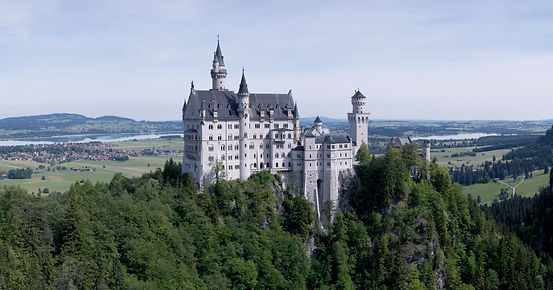
Schloss Neuschwanstein, or the Neuschwanstein Castle, which is a hallmark castle of Germany, is in the southern part of Bavaria, almost directly upon the border of the neighboring country, Liechtenstein. Ludwig built Neuschwanstein to bring what he believed to be “a return of cultural heritage and cultural pride” to the kingdom of Bavaria. Although the castle was never completed, 14 rooms are available for viewing with a guided tour, even though there were originally supposed to be 200 rooms.
Ticket costs are 13 Euros for people over 18 and free for people under 18 (That makes it a rather friendly place to go for families with young children!). There is the availability of a person-guided tour, which are offered in German or English, and there is also an audio-casette which you can request in 16 other languages. The tour lasted about half an hour. Click the button to visit the Neuschwanstein webpage.
Linderhof Castle is about 40 kilometers west of Neuschwanstein, and includes only four functional rooms, one of which had almost no function. The Castle’s structure itself is meant to mimic the French palace of Versailles, a palace whose king Ludwig adored. The Castle also includes a park and garden area, where Ludwig built an artificial cave and grotto in which plays could be performed, but it was also tribute to the German composer, Richard Wagner’s, Tannhauser. Tickets to see Linderhof Castle are sold for 8.50 Euros, and people under 18 get in for free, making this palace another family-friendly place to see for people with young children. Click the button to visit Schloss Linderhof's webpage.

The Second Trip: Chiemgau
The Stay:
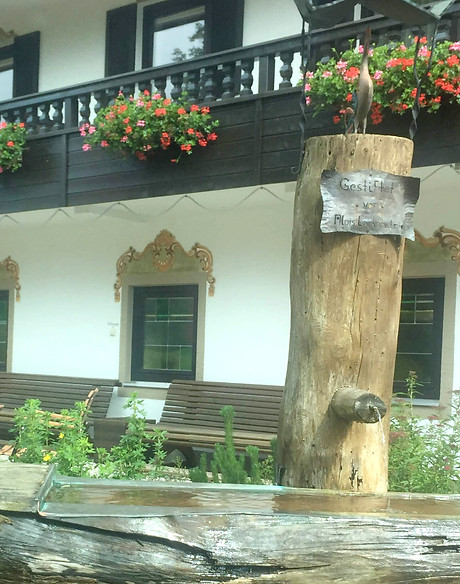
Altogether, the stay was peaceful, quiet and pleasant. The cost of staying there starts at approximately 91 Euros per night, although the prices may vary depending on the size of the room booked. Click the button to visit the webpage for Hotel Farbingerhof.
During my second stay in the Bavarian countryside, we stayed in a rural hotel Farbingerhof located both near the scenic Kampenwand and the Bavarian Sea, offering a double bed, a balcony, and a full bathroom.
One thing that is important to mention in any European hotel is whether or not you want a bathroom. Even after mentioning your preference, you always have to be specific about whether you want just a toilet, just a shower, or a shower and a toilet. While full-fledged bathrooms are compulsory in American hotels, that is not the case in Europe. There, rooms with a bathroom will often cost extra. Also be where that residential buildings in Europe don't have air-conditioning, so be wary if you cannot even handle the slightest bit of heat.
Luckily, the hotel we opted to stay in only had rooms with full-fledged bathrooms, so that was not an issue for us (my family and I). Our stay also came with two meals a day, included with the stay, and each night there would be a cafeteria line where people could choose what they wanted. The food itself was quite good at dinner, typically offering a type of meat, potatoes, and a different green depending on the day, as well as salad options and desserts. After dinner, one could opt to get a pitcher of wine—which we often enjoyed by sitting in the outdoor seating area. Breakfast was typically quite German with a simple Brötchen (which translates into “cute little bread”) with jam, honey, or Nutella, and a drink of choice (coffee, milk, orange juice—not many people drink tea there, but they did offer it).
Site-seeing & Itinerary Recommendations:
Schloss Herrenchiemsee is Ludwig’s third palace. The garden and staircase mimic the palace of Versailles exactly, but was, like the other two castles, never finished. Only 20 rooms of the castle were completed and are now shown in the guided tour of the castles, as opposed to the 70 rooms the castle was supposed to have. To reach the castle from the hotel, we had to book a ferry (costing around 10 Euros for adults and 5 Euros for people aged 5 to 14). The castle itself is located on Herreninsel (translating into “Men’s Island), an island within the Bavarian Sea. Then, we opted to take a carriage (offered only in summer, and costing 3.50 Euros for adults and 1 Euro for people aged 5 to 14) the rest of the way to the castle. The tour of the castle itself costed 5 Euros per person, while people under 18 received free admission. Click the button to land on the webpage for Schloss Herrenchiemsee.
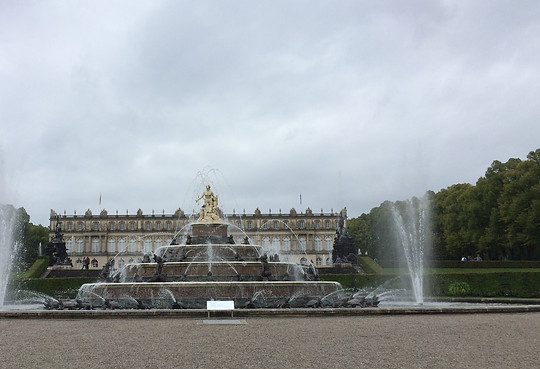
Frauen-Insel:
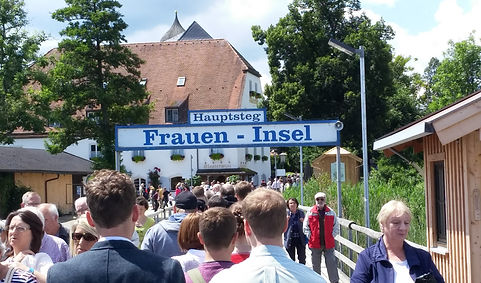
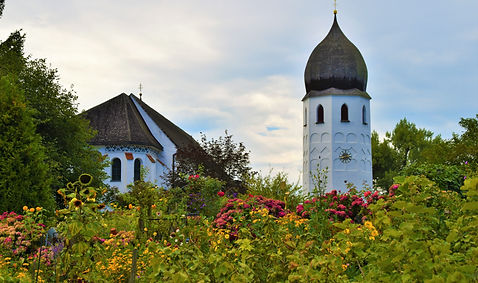
After visiting the Schloss Herrenchiemsee, we also opted to visit the Fraueninsel (translating into “Women’s Island”). The Fraueninsel is smaller island located near the Herreninsel island, and houses both an abbey, a cemetery, and a small village. In the past, while the island used to be strictly for nuns, it is now a popular tourist destination for tourists in the area, and all sorts of hand-crafted goods are sold there. I recommend paying this island a visit for its scenery and beutiful handmade items.
Kampenwand:

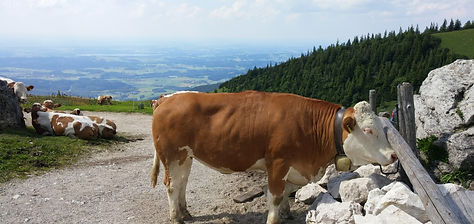
The Kampenwand is a mountain near Farbingerhof Hotel, which is noted to be the highest marked summit in the state of Bavaria. The experience itself was wonderful—green grass, clear skies, the occasional cow mooing in the background. Those who live in the area live a rather pastoral lifestyle, with their livelihood being dairy farming. On top of the mountain is also a rest stop, where people can order coffee, cake, or other refreshments. Another plus of the mountain is that it’s a hiking activity, and is therefore, free.
Berchtesgarden, Obersalzberg, and Kehlsteinhaus
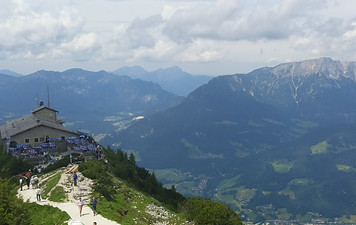

Berchtesgarden is a small town in Bavaria, near the Austrian border, known for being directly under the mountain, Obersalzberg, which houses the Kehlsteinhaus. Kehlsteinhaus ( also known as 'The Eagle's Nest') was known to be Hitler’s place of business while he stayed at his vacation home, Berghof, in Berchtesgarden.
After World War II, although most Nazi ruins were destroyed, the Kehlsteinhaus was untouched. Today, it stands as a reminder of the deluded past and has been renovated into a full-fledged restaurant.
The building is rather high up at 124 meters high (from the bus departure point), so the only way to reach it quickly is by bus. The bus and elevator tickets combined cost around 16 Euros for adults and 10 Euros for people aged 6 to 14. The building itself is reached via an elevator that shoots 124 meters through the mountain to reach the Kehlsteinhaus building. One interesting fact is that Hitler himself was a afraid of the elevator, partially due to what most people believed to be clausterphobia, and also because he believed the elevator could be struck by lightning, killing everyone inside. Personally, I find a concern for personal space ironic, coming from someone who eliminated the space of so many other people.
Click on the button to visit the official webpage for Kehlsteinhaus.

The Schloss Hohenaschau was a castle built during the Medieval period, which transferred owners several times throughout its existence. The castle, near our hotel, was a place we had originally not intended to go see, but rather a discovery by accident while taking a stroll in a local forest trail near the hotel.
The tour of the castle cost 5 Euros for adults and 3 Euros for people aged 6 to 16. However, the guide was about to close up for the day, saw us, and decided to give us the tour for free and for fun (the tour guide was also happy that he was able to give the tour in German, since everyone was able to understand it—demonstrating that it is always worth learning the language of a country one intends to travel to).
However, while the tour guide spoke German, he spoke a specific dialect called “Bavarian German,” a dialect almost unintelligible even by those who spoke “High German,” a dialect spoken in the northern states. An interesting fact about Germany is that each region has its own dialect, but while most regions’ dialects are still mutually intelligible, Bavarian German is less so (even though I still understood, since the basic syllables, sounds, and structures are still the same as High German).
During the tour, our guide spoke about the way people in the castle lived, and showed us all the different rooms, the most memorable being the chamber of resolution, where villagers or diplomats who had fought with one another would be placed and locked into a device which suspended their hands and made them face each other until they worked out their differences by talking—a device which I believe would have been of more use during some points in history (locking every world leader together for a while and having them eventually learn peace and the art of talking things through). While we were there, he demonstrated by locking my younger brother and I in the resolution shackles, as shown in the image to the right.
The next image is the castle's chapel, where services and weddings are still held today. Click the button to visit the castle's webpage.
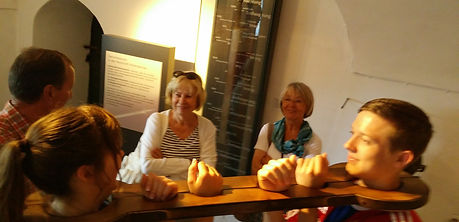

So... Why do I love Bavaria so much?
There are several reasons that the Bavarian countryside is my favorite place to visit. The people of the Bavarian countryside are very relaxed, the atmosphere is calming and peaceful, the air is clear, and--almost no matter where you go, the view is amazing.